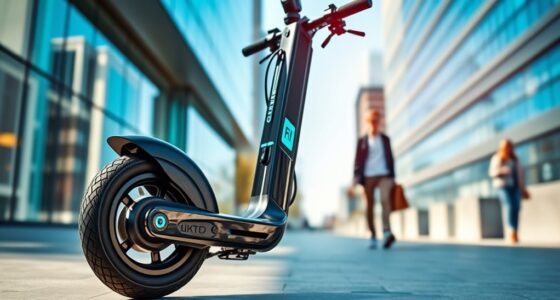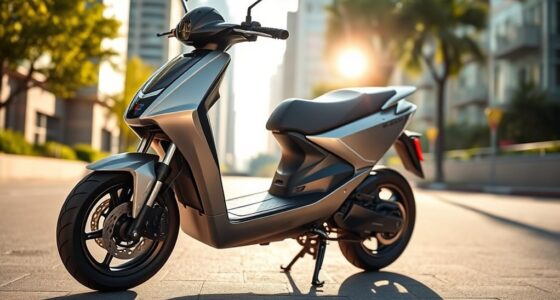If you’re looking for the best MacBook Pros for data science and AI in 2025, I’d recommend models with the latest M4 Max or M4 Pro chips, high RAM (up to 36GB), and fast SSD storage. The 14- and 16-inch Liquid Retina XDR displays will give you vibrant visuals and precision. Portability, battery life, and connectivity matter too, so I’ll share top options that balance power and usability—stay tuned to find out which one fits your needs perfectly.
Key Takeaways
- MacBook Pros equipped with M4 Max, M4 Pro, or M3 Max chips deliver exceptional processing power for demanding AI and data science workloads.
- High-resolution Liquid Retina XDR displays with ProMotion technology enable precise data visualization and model evaluation.
- Up to 128GB RAM and fast SSD storage support large datasets, multitasking, and accelerated data processing tasks.
- Extensive connectivity options, including Thunderbolt 5 and HDMI, facilitate complex workflows with external devices and high-resolution displays.
- Premium build quality, portability, and long battery life ensure reliable, on-the-go performance for professional data science and AI applications.
Apple MacBook Pro 2024 with M4 Max, 14-inch Liquid Retina XDR Display, 36GB RAM, 1TB SSD

If you’re looking for a powerhouse laptop that can handle demanding data science and AI workloads, the Apple MacBook Pro 2024 with M4 Max is an excellent choice. Its Apple M4 Max chip features a 14-core CPU, 32-core GPU, and a 16-core Neural Engine, delivering blazing performance. With 36GB of unified memory and a 1TB SSD, it manages large datasets and complex models effortlessly. The 14-inch Liquid Retina XDR display offers stunning visuals with 1 billion colors and high HDR brightness. This MacBook Pro is built for professional workflows, combining speed, efficiency, and stunning visuals in a sleek, portable design.
Best For: creative professionals, data scientists, and AI developers seeking a powerful, portable machine with top-tier performance and stunning display quality.
Pros:
- Exceptional processing power with M4 Max chip for demanding workloads
- Stunning 14-inch Liquid Retina XDR display with high HDR brightness and color accuracy
- Long battery life supporting extended work sessions and multimedia consumption
Cons:
- High cost making it less accessible for casual users
- Heavier and larger than more compact laptops, impacting portability
- Limited upgrade options post-purchase, especially for RAM and storage
Apple MacBook Pro Laptop with M4 Max, 14-inch Liquid Retina XDR Display

The Apple MacBook Pro with M4 Max and a 14-inch Liquid Retina XDR display stands out as the top choice for data scientists and AI professionals who demand peak performance and stunning visuals. Powered by the robust M4 Max chip, it offers a 14-core CPU, up to a 40-core GPU, and 546GB/s memory bandwidth, handling demanding workloads like coding, 3D rendering, and media processing with ease. The vibrant 3024×1964 display features true blacks, rich colors, and ProMotion technology for smooth visuals. Its sleek design, excellent battery life, and extensive ports make it perfect for intensive workflows, creative tasks, and professional use in 2025.
Best For: data scientists, AI professionals, and creative power users who require high performance, exceptional visuals, and extensive connectivity options for demanding workflows.
Pros:
- Exceptional processing power with the M4 Max chip, ideal for intensive tasks like coding, rendering, and media editing
- Stunning 14-inch Liquid Retina XDR display with ProMotion technology for smooth, vibrant visuals
- Extensive port selection including Thunderbolt 5, HDMI, SDXC, and multiple external display support for versatile connectivity
Cons:
- Premium price point may be prohibitive for some users
- Heavier than some ultraportable laptops, potentially affecting portability despite its sleek design
- Limited upgradeability post-purchase, especially regarding storage and memory configuration
Apple 2024 MacBook Pro Laptop with M4 Max
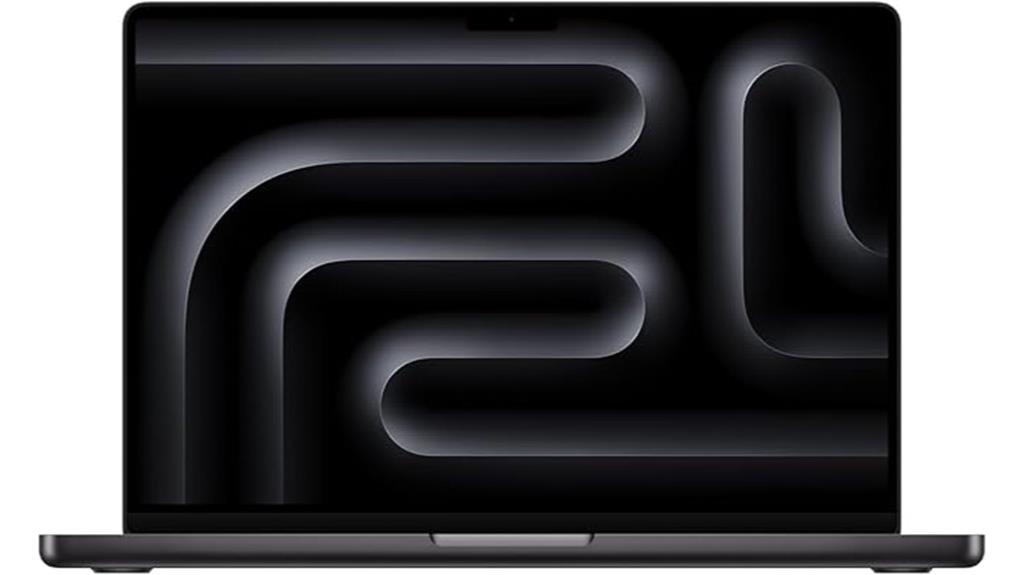
For data scientists and AI professionals demanding top-tier performance, the 2024 MacBook Pro with M4 Max is the ultimate choice. Its M4 Max chip handles complex workflows like rendering detailed 3D content and managing massive data sets with ease, while the M4 Pro excels at demanding coding tasks. The 14.2-inch Liquid Retina XDR display provides stunning visuals with high brightness and contrast, perfect for analyzing intricate data visualizations. With 36GB of unified memory and a 1TB SSD, it offers fast, reliable storage and multitasking. Plus, seamless Apple ecosystem integration keeps workflows smooth, making this MacBook Pro a powerhouse for any serious data scientist or AI developer.
Best For: data scientists and AI professionals seeking top-tier performance for complex workflows, data analysis, and creative visualization.
Pros:
- Exceptional processing power with M4 Max chip for demanding tasks like 3D rendering and large data set management
- Stunning 14.2-inch Liquid Retina XDR display with high brightness and contrast for detailed data and visual analysis
- Extensive 36GB unified memory and 1TB SSD provide fast, reliable multitasking and storage
Cons:
- Premium price point may be a barrier for some users
- Limited ports could require additional adapters for connectivity
- The sleek design might be less durable under heavy industrial use
Apple 2024 MacBook Pro Laptop with M4 Chip
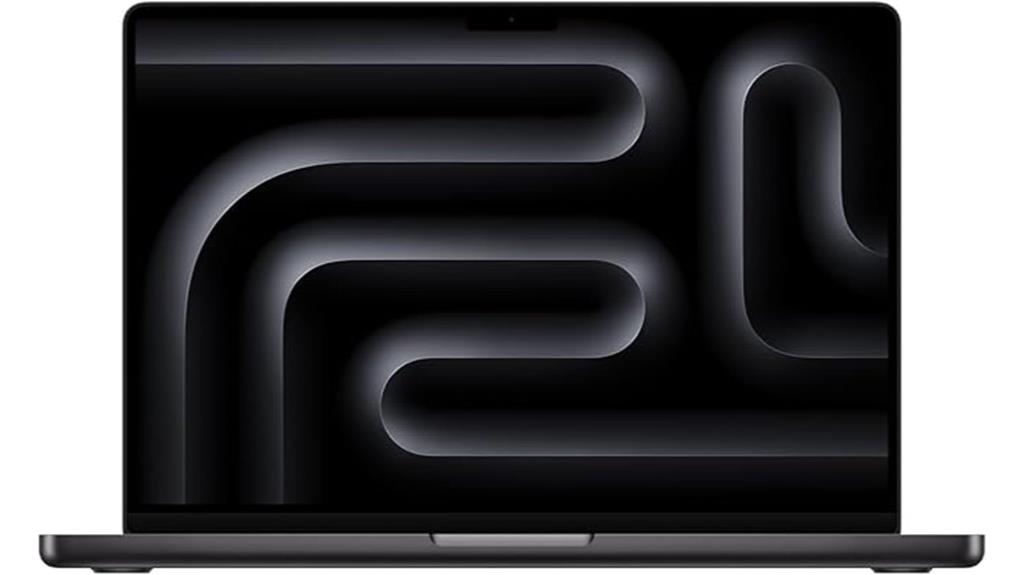
Powered by the new M4 chip, the 2024 MacBook Pro delivers exceptional performance that’s perfect for data scientists and AI professionals. Its 10-core CPU and GPU, combined with a 16-core Neural Engine, handle demanding tasks with ease. The device features up to 24GB of unified memory and fast SSD storage, ensuring smooth multitasking and quick data access. The 14.2-inch Liquid Retina XDR display offers stunning visuals with high brightness and color accuracy. With impressive battery life, extensive connectivity options, and advanced audio and camera systems, this MacBook Pro is a powerful, reliable tool for high-performance work in AI and data science.
Best For: data scientists, AI professionals, and creatives seeking high-performance computing and stunning visual display in a portable, premium design.
Pros:
- Exceptional processing power with M4 chip, 10-core CPU and GPU, and Neural Engine for demanding tasks
- Bright, color-accurate Liquid Retina XDR display supporting high-resolution visuals and ProMotion technology
- Extensive connectivity options including Thunderbolt 4, HDMI, SDXC slot, and multiple external display support
Cons:
- Premium price point may be a barrier for some users
- Limited upgradability due to integrated hardware design
- Battery life, while impressive, may vary depending on intensive workload usage
Apple 2024 MacBook Pro with M4 Max Chip, 16-inch, 36GB RAM, 1TB SSD, Silver (Renewed)
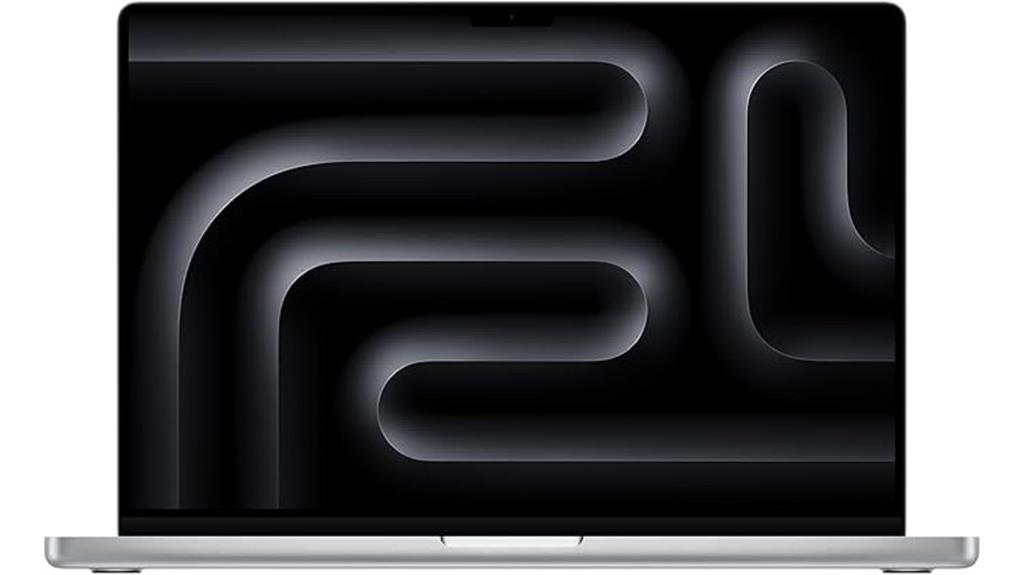
If you’re tackling complex data science projects or AI workflows, the Apple 2024 MacBook Pro with M4 Max chip is a top contender thanks to its incredible processing power and 36GB of RAM. The M4 Max handles demanding tasks like rendering detailed 3D content and managing large datasets effortlessly. Its 16.2-inch Liquid Retina XDR display offers stunning visuals with high brightness and contrast, perfect for creative work. With all-day battery life and seamless macOS integration, this renewed silver model combines power, portability, and style—making it an ideal choice for professionals who need reliable performance without compromise.
Best For: professionals engaging in complex data science, AI workflows, and creative tasks requiring high performance and large memory capacity.
Pros:
- Exceptional processing power with M4 Max chip handling demanding workloads with ease
- Large 36GB RAM ensures smooth multitasking and efficient large dataset management
- Stunning 16.2-inch Liquid Retina XDR display provides vibrant visuals ideal for creative work
Cons:
- Renewed model may have limited warranty or warranty coverage compared to new products
- High-performance features and large storage can come at a premium price point
- As a larger 16-inch model, it may be less portable for users seeking ultra-light laptops
Apple 2024 MacBook Pro Laptop with M4 Max
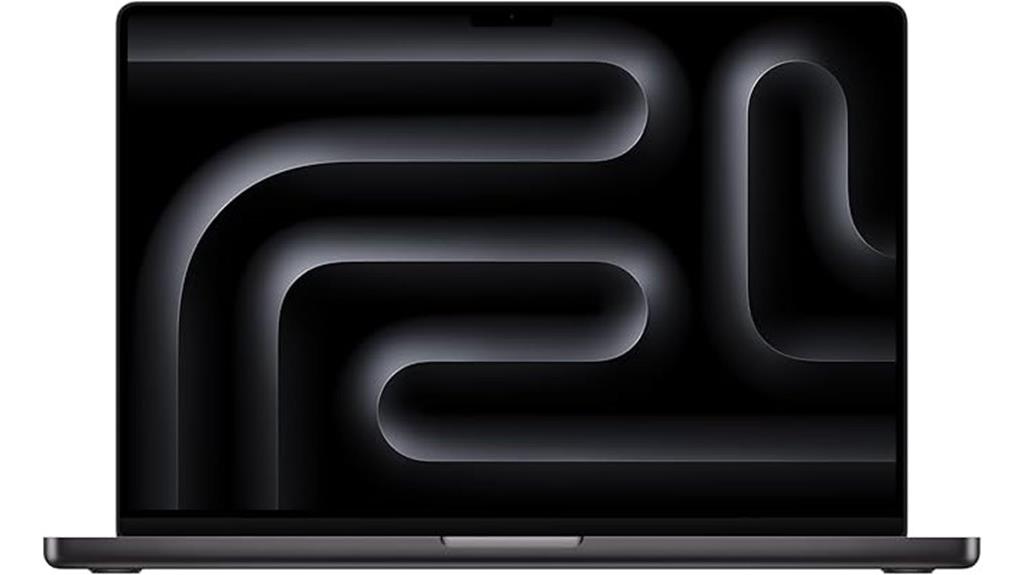
The Apple 2024 MacBook Pro with M4 Max stands out as an ideal choice for data scientists and AI developers demanding top-tier performance. It’s powered by Apple’s M4 Max chip, featuring a 16-core CPU, 40-core GPU, and 16-core Neural Engine, making it exceptional for demanding workflows like 3D rendering and large-scale data processing. The device supports multiple external displays, offers blazing-fast data transfer with 546GB/s bandwidth, and runs intensive applications effortlessly. Its stunning 16.2-inch Liquid Retina XDR display guarantees precise visuals, while the sleek design and seamless Apple ecosystem integration make it a professional powerhouse for data science and AI tasks.
Best For: professionals in data science, AI development, and demanding creative workflows seeking top-tier performance and exceptional display quality.
Pros:
- Exceptional processing power with the M4 Max chip, ideal for intensive tasks like 3D rendering and large data processing.
- Stunning 16.2-inch Liquid Retina XDR display with high brightness, contrast, and color accuracy for precise visuals.
- Seamless integration with the Apple ecosystem and support for multiple high-resolution external displays.
Cons:
- High price point may be a barrier for some users or organizations.
- The device’s weight and size could impact portability for on-the-go use.
- Battery life, while impressive, may decrease under heavy workloads due to the device’s powerful hardware.
Apple MacBook Pro 14-inch with M4 Pro Processor
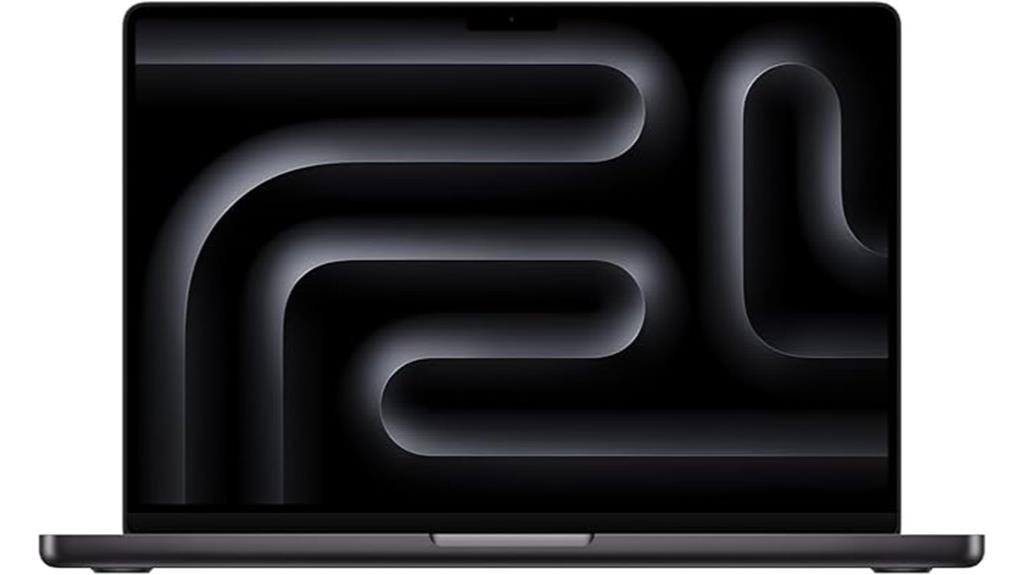
The Apple MacBook Pro 14-inch with M4 Pro Processor stands out as an ideal choice for data scientists and AI professionals demanding top-tier performance. Equipped with a 12-core CPU and 16-core GPU, it easily handles demanding tasks like compiling millions of lines of code or rendering complex 3D content. Its 14.2-inch Liquid Retina XDR display offers vibrant visuals with deep blacks and high brightness, perfect for detailed work. The all-day battery life ensures productivity on the go, while 24GB of unified memory and 512GB SSD storage support seamless multitasking and ample space. Seamless integration with the Apple ecosystem further enhances its appeal for professional use.
Best For: data scientists and AI professionals seeking a powerful, portable laptop with exceptional performance and vibrant display capabilities.
Pros:
- Equipped with a 12-core CPU and 16-core GPU for demanding tasks like coding and rendering.
- Stunning 14.2-inch Liquid Retina XDR display with high brightness and deep blacks.
- All-day battery life and seamless Apple ecosystem integration for enhanced productivity.
Cons:
- Limited to 512GB SSD storage, which may require external storage for large projects.
- Premium pricing can be a barrier for some users.
- The device’s lightweight design might compromise some upgradeability options.
Apple MacBook Pro 14-inch Laptop with M4 Pro (512GB, Space Black)
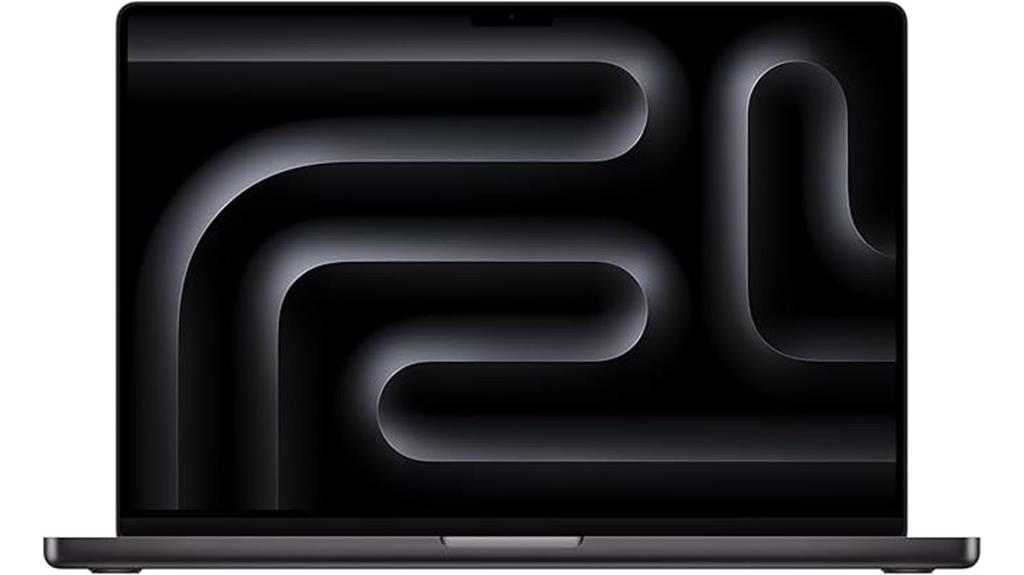
Designed for demanding data science and AI workloads, the Apple MacBook Pro 14-inch with M4 Pro excels thanks to its powerful 16-core CPU and 20-core GPU options. Its 48GB unified memory and 512GB SSD provide fast data access and multitasking capabilities. The 16.2-inch Liquid Retina XDR display offers stunning visuals with peak brightness of 1600 nits and exceptional contrast, perfect for visual-heavy tasks. Built in Space Black, it combines elegance with durability. With all-day battery life and seamless macOS integration, this model handles complex workflows like 3D rendering and code compilation efficiently, making it a top choice for professionals.
Best For: professionals and power users engaging in demanding tasks like data science, AI workflows, 3D rendering, and creative projects who need a high-performance, reliable laptop with exceptional display quality and seamless Apple ecosystem integration.
Pros:
- Exceptional performance with M4 Pro chip, 48GB memory, and 20-core GPU for intensive workloads
- Stunning 16.2-inch Liquid Retina XDR display with 1600 nits brightness and high contrast for visual accuracy
- Durable and elegant Space Black design with high-quality build and long-lasting battery life
Cons:
- High price point (~$3,600) may be a barrier for some users
- Slightly heavier and larger, which could impact portability for on-the-go use
- 512GB storage might fill up quickly for large projects, requiring external SSDs
Apple 2024 MacBook Pro Laptop with M4 Pro
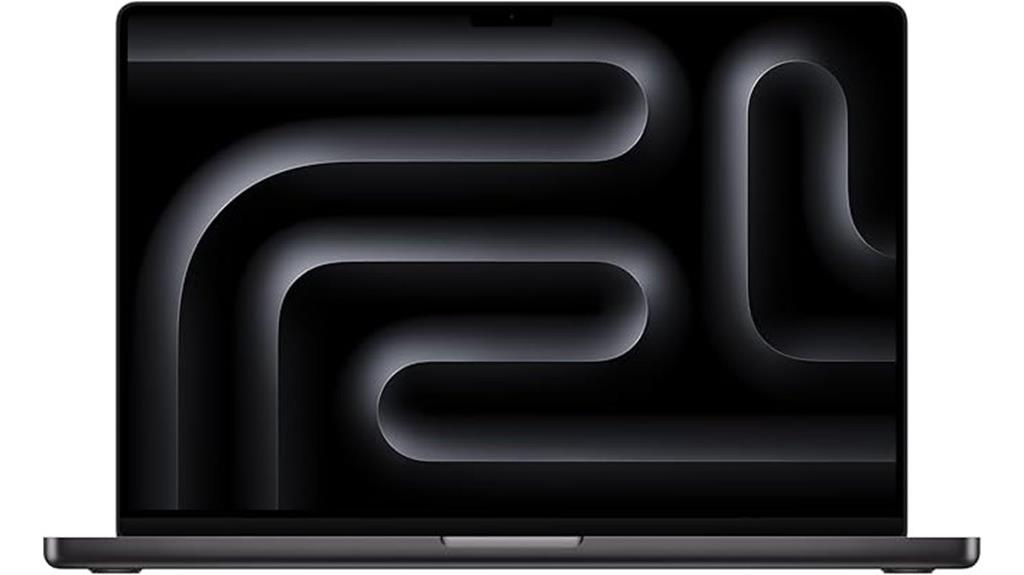
Looking for a powerful laptop that can handle intensive data science and AI workloads? The Apple 2024 MacBook Pro with M4 Pro delivers exceptional performance with its 14-core CPU, 20-core GPU, and up to 128GB of RAM. Its 16.2-inch Liquid Retina XDR display offers stunning visuals with 1600 nits brightness and support for a billion colors, perfect for data visualization. Weighing around 4.71 pounds, it’s built for portability and durability. With up to 24 hours of battery life, Thunderbolt 5 ports, and high-speed connectivity, this MacBook Pro is a top choice for demanding AI and data science tasks.
Best For: professionals and creatives who require a powerful, portable laptop with exceptional display quality and long battery life for demanding tasks like data science, AI, video editing, and 3D rendering.
Pros:
- Outstanding performance with M4 Pro chip, up to 128GB RAM, and high-speed SSD options
- Stunning 16.2-inch Liquid Retina XDR display with true-to-life colors and high brightness
- Excellent battery life supporting up to 24 hours of usage on a single charge
Cons:
- Heavy weight at approximately 4.71 pounds, which may impact portability for some users
- Premium price point that could be a barrier for budget-conscious buyers
- Limited to demanding workflows, might be overkill for casual or lightweight use
Apple 2023 MacBook Pro with Apple M3 Max (16-Inch, 36GB RAM, 1TB SSD, Space Black)
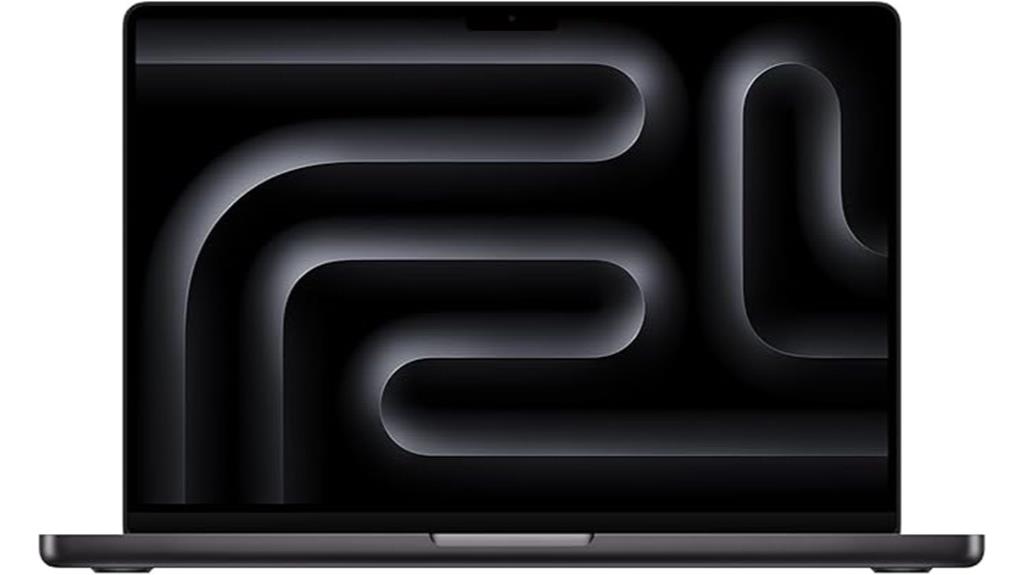
If you need a powerhouse that can handle demanding data science and AI tasks, the Apple 2023 MacBook Pro with M3 Max is an excellent choice. It features a 16-inch display, a 4.05 GHz Apple M3 Max processor, and 36GB of unified memory, ensuring smooth multitasking and heavy computations. The 1TB SSD provides fast storage, while the 30-core GPU delivers impressive graphics performance. Despite being pre-owned, it’s professionally inspected and in excellent condition, with a battery exceeding 80%. Customers praise its performance, reliability, and like-new appearance, making it a compelling option for serious data scientists and AI professionals seeking power and precision.
Best For: power users such as data scientists, AI professionals, and multimedia creators who require high-performance computing on a portable device.
Pros:
- Exceptional processing power with a 4.05 GHz M3 Max chip and 36GB RAM for demanding tasks
- Large 16-inch display with high-quality graphics thanks to 30-core GPU, ideal for visual work and multitasking
- Professionally inspected, in excellent condition, with a long-lasting battery exceeding 80% capacity
Cons:
- Pre-owned and not Apple-certified, which may concern some buyers about warranty and authenticity
- Heavier weight (7.1 pounds) making it less portable for on-the-go use
- Accessories may not be original, and the product may come in a generic box, potentially affecting packaging expectations
Factors to Consider When Choosing a Macbook Pro for Data Science and AI

Choosing the right MacBook Pro for data science and AI depends on several key factors. I consider processor power, memory, storage, display quality, and battery life to guarantee ideal performance. Understanding these points helps me pick a machine that meets my specific workflow needs.
Processor Power and Cores
The number of CPU cores in a MacBook Pro directly influences its ability to handle the demanding tasks involved in data science and AI. More cores mean better performance in parallel processing tasks, which are essential for training models and analyzing large datasets. A MacBook Pro with 14 or 16 cores can execute complex algorithms faster and manage multitasking more efficiently. Multi-core processors also improve performance in AI workflows by distributing workloads across cores, reducing bottlenecks. Additionally, having both performance and efficiency cores helps optimize power consumption without sacrificing power. This combination ensures smooth operation of resource-intensive applications like TensorFlow, PyTorch, and data visualization tools, making a multi-core processor a vital factor in selecting a powerful MacBook Pro for data science and AI tasks.
Memory Capacity Needs
When selecting a MacBook Pro for data science and AI, memory capacity is a critical factor that directly impacts performance. For handling large datasets and complex computations, at least 16GB of RAM is recommended to guarantee smooth operation. If you work with multiple AI models or high-resolution visualizations simultaneously, higher capacities like 36GB or more can considerably boost performance. For future-proofing and more demanding workloads, upgrading to 48GB, 64GB, or even 128GB is advisable. Adequate memory allows for seamless multitasking across data analysis tools, IDEs, and AI frameworks, reducing swapping and lag. Basically, the more memory you have, the better your workflow, enabling you to process extensive datasets efficiently and focus on insights rather than technical bottlenecks.
Storage Space Availability
Ensuring sufficient storage space is essential for smooth data science and AI workflows on a MacBook Pro. Large datasets, project files, and multimedia assets require ample room to operate efficiently. I recommend choosing a MacBook Pro with at least 1TB SSD, as this not only provides enough space but also guarantees faster read/write speeds, speeding up data processing and model training. For more extensive projects, 2TB or more offers the flexibility to store multiple datasets, models, and software tools without relying heavily on external drives. While external Thunderbolt 4 or 5 drives can supplement internal storage, having plenty of internal space minimizes data transfers and interruptions. This setup helps streamline workflows, keeping productivity high even with demanding, data-heavy tasks.
Display Clarity and Brightness
A high-quality display makes a noticeable difference in how effectively I can analyze data and evaluate AI models. With a resolution that delivers vibrant, accurate visuals, I can spot patterns and details that might otherwise go unnoticed. The peak brightness of 1600 nits and contrast ratio of 1,000,000:1 ensure that even complex visualizations are clear and vivid. Support for one billion colors and the wide P3 color gamut allow me to see precise color variations, crucial in data analysis and model validation. The ProMotion technology with up to 120Hz refresh rate makes scrolling smooth and updates during interactive sessions seamless. Plus, HDR capability enhances visibility of fine details in HDR content, helping me interpret complex visual data effortlessly.
Battery Longevity and Charging
Long-lasting battery life is essential for data science and AI tasks because it allows me to work uninterrupted through lengthy training sessions and complex analyses. A high-capacity battery assures I can handle large datasets and resource-heavy models without constantly searching for power outlets. Fast-charging capabilities are equally important, as they let me quickly recharge and reduce downtime during intensive workflows. Battery health management features, like optimized charging and cycle controls, help preserve battery capacity over years, maintaining performance. A combination of energy-efficient hardware and a robust battery supports sustained high-performance computing without overheating or throttling. This reliability keeps my focus on data and model development, rather than worrying about power interruptions or degradation over time.
Compatibility With AI Tools
Choosing a MacBook Pro with the right hardware is essential for compatibility with AI tools and frameworks. I look for a high-performance CPU and GPU, like the M4 Max, to efficiently handle intensive AI model training and data processing. Support for hardware-accelerated media engines and ray tracing is pivotal, as these features speed up workflows and large-scale computations. I also verify that the device has ample unified memory—at least 36GB—to manage multitasking and large datasets seamlessly. Compatibility with popular AI frameworks such as TensorFlow, PyTorch, and Core ML, optimized for Apple Silicon, is indispensable. Additionally, the ability to connect external GPUs or high-speed peripherals via Thunderbolt ports can expand processing power, ensuring my MacBook Pro remains versatile for advanced AI and data science tasks.
Port Selection and Connectivity
Selecting the right port configuration on a MacBook Pro is essential for seamless data science and AI workflows. I look for multiple Thunderbolt 4 or 5 ports to support high-speed data transfers and external GPUs or storage devices. An HDMI port and SDXC card slot are necessary for directly transferring large datasets and multimedia files from cameras or storage cards. Fast charging via USB-C or MagSafe minimizes downtime during intensive processing sessions. I also guarantee the MacBook can connect to multiple external displays simultaneously, which is critical for multi-monitor data analysis. Lastly, I consider the overall variety and compatibility of ports with peripherals like AI accelerators, external drives, and specialized hardware. This setup ensures I can efficiently manage data and hardware without constant adapters or limitations.
Portability and Weight
When it comes to data science and AI work on a MacBook Pro, portability and weight are crucial factors that can influence your workflow. Lighter models, like the 14-inch variants weighing around 3.56 pounds, are more convenient for frequent travel and on-the-go tasks. They fit easily into backpacks or briefcases, making them ideal for fieldwork or commuting. In contrast, larger 16-inch models, at roughly 4.73 pounds, offer bigger screens but may be less practical for daily movement. Additionally, newer MacBook Pros feature slim profiles, further enhancing mobility. Extended battery life—up to 24 hours in some models—means you can work longer without carrying extra power sources. Overall, choosing a lighter MacBook Pro maximizes portability, while heavier models prioritize screen size and raw performance.
Frequently Asked Questions
How Does Battery Life Impact Long Data Science Projects on Macbook Pros?
Battery life really influences my ability to work on long data science projects without interruptions. When my MacBook Pro’s battery lasts longer, I can analyze datasets, run models, and experiment without constantly searching for power sources. Poor battery life forces me to save frequently or find sockets, which slows me down. So, a strong battery guarantees I stay productive, focused, and efficient throughout extended work sessions.
What Specific GPU Features Enhance AI Model Training on These Macbooks?
Imagine a Tesla accelerating—GPU features on MacBook Pros boost AI training similarly. The dedicated GPU cores, like Apple’s Metal architecture, accelerate parallel processing, speeding up complex model training. Neural Engine optimizations also help with machine learning tasks. These features enable smoother, faster AI workflows, making your data science projects more efficient without sacrificing portability. It’s like having a mini supercomputer in your laptop, ready to power your AI innovations.
Are There Any Compatibility Issues With Popular Data Science Software on M4 Chips?
Compatibility issues with popular data science software on M4 chips are minimal. I’ve found most tools like TensorFlow, PyTorch, and Jupyter work smoothly thanks to Apple’s Rosetta 2 translation layer. However, some niche or older packages might need updates or workarounds. Overall, I’d say the M4 chip’s performance and compatibility are impressive, making it a solid choice for data science tasks.
How Does Thermal Management Affect Sustained Performance During Intensive Tasks?
Thermal management is essential for maintaining sustained performance during intensive tasks. When my MacBook gets hot, it automatically reduces CPU and GPU speeds to prevent overheating, which can slow down my work. Good airflow and efficient cooling systems help keep temperatures down, allowing me to run demanding data processing or AI models longer without performance dips. Proper thermal management guarantees my MacBook stays reliable and powerful under pressure.
Can Macbook Pros Handle Multi-Gpu Configurations for Advanced AI Workloads?
Can MacBook Pros handle multi-GPU configurations for advanced AI workloads? Honestly, not really. MacBooks are designed with integrated graphics or a single powerful GPU, but they don’t support multi-GPU setups like some high-end desktops. If you’re working with demanding AI tasks, you’ll probably need a desktop workstation or cloud solutions. MacBooks excel in portability and power, but multi-GPU configs just aren’t part of their game.
Conclusion
If you’re serious about data science and AI, investing in a powerful MacBook Pro is a game-changer. Did you know that the latest M4 Max chip offers up to 20% faster performance than previous models? This means smoother workflows and quicker insights. Whether you choose the 14-inch or 16-inch, these machines are built to handle demanding tasks with precision. Upgrading now could elevate your projects and boost your productivity in 2025 and beyond.


